Tags
Canada goose, cormorant, curlew, Herring gull, hydrangea, King Harry Ferry, National Trust, oystercatcher, Pendennis Castle, River Fal, shelduck, St Michael's Mount, swan, The Old Quay House, Trelissick, Trencrom
(‘Tre..’ means ‘homestead’ in Cornish.)
Sunday, 3rd July. Membership of The Newt in Somerset gives free entry to a few other gardens in the UK (and one in South Africa!). I had my eye on two of them as I considered what to do on my last day in Cornwall. But I found that neither Trebah nor Tregothnan opens on a Sunday. So I turned to my booklet, ‘Cornwall’s Archaeological Heritage’ for the first time this week, and also to my National Trust handbook. The former told me about Trencom Castle, a hill fort just a few minutes from where I was staying. Among other things it told me that, “The enclosure may have originated in the Neolithic period and many flint arrowheads were found here in the early 20th century.” So I made this my first destination. But first I had of course to look out to see what was happening in the RSPB reserve, and have some breakfast.

Guess who appeared while I was eating. But at least today he didn’t tap on my window.

I really like these Cornish stiles – especially if they provide a post to hold on to.

The top of the fort was not high, about 180 metres (the same as Glastonbury Tor), and my car was parked at 135, so not much effort was needed. The path was well trodden.



Yet another view of St Michael’s Mount


I didn’t stay at the top for long, not least because there was a party of walkers up there disturbing the peace.

The main visit of the day was to Trelissick House, National Trust. ‘The estate has been in the ownership of the National Trust since 1955 when it was donated by Ida Copeland following the death of her son Geoffrey. A stained glass memorial bearing the Copeland coat of arms was donated to Feock parish church by Mrs. Copeland. The house and garden had formerly been owned and developed by the Daniell family, which had made its fortune in the 18th century Cornish copper mining industry.’ (Wikipedia, which does history so much better than does the National Trust on its site) The Copelands had been co-owners of Spode, the ceramics company based in Stoke-on-Trent.

I started in the garden and grounds.











At the entrance there had been a notice saying a choir would be singing on the terrace of the house at 1.00 pm. I heard their songs wafting towards me as I wandered around, and at one stage was near enough to zoom a photo on it. I thought how pragmatic the uniform was in the not very warm weather. Blue jeans of any hue and any black top.

I went round to the front of the house and looked round. ‘Trelissick is not your typical country house visit. It is presented as neither home nor museum, but was opened in 2014 simply as a place to enjoy the view. It plays host to a modest collection – including ceramics …’ Here is one which rather pleased me.

Arriving in the small café very late for lunch, I was fortunate to get the very last portion of soup. Visitors were allowed to take their food to any of several rooms. Most of the places were taken, and I ended up in what was called the Solarium, (which I would have called an Orangery otherwise). It was very warm there, unlike outdoors. This was my view.

I think these were ensconced in the Drawing Room for the afternoon!

It became warm and sunny enough to sit out on the sheltered terrace. The choir had long gone, and I found a vacant deckchair.

Not a bad view.

I heard someone nearby talk about a castle in the distance, and sure enough, with my camera on maximum zoom, I could see Pendennis Castle, about 800 metres away, in Falmouth. (It’s on the list for next year.)

Back for my last evening at The Old Quay House, I spent my time, as every evening bar Friday (Minack), divided between Wimbledon and bird-watching.






Home the next day, but the visits aren’t over…











































































 The briefing told us that the land had been in cultivation until 2003, when it was bought by the RSPB and converted into wetland for wildlife. We would make our way to the main hide, where we would spend about half our time, and then walk around those parts accessible to the public. Most of the area was kept behind electric fencing for the tranquillity of the birds and animals. It was good to come at all times of the year, but this season was the best time because of the thousands of different birds over-wintering there.
The briefing told us that the land had been in cultivation until 2003, when it was bought by the RSPB and converted into wetland for wildlife. We would make our way to the main hide, where we would spend about half our time, and then walk around those parts accessible to the public. Most of the area was kept behind electric fencing for the tranquillity of the birds and animals. It was good to come at all times of the year, but this season was the best time because of the thousands of different birds over-wintering there.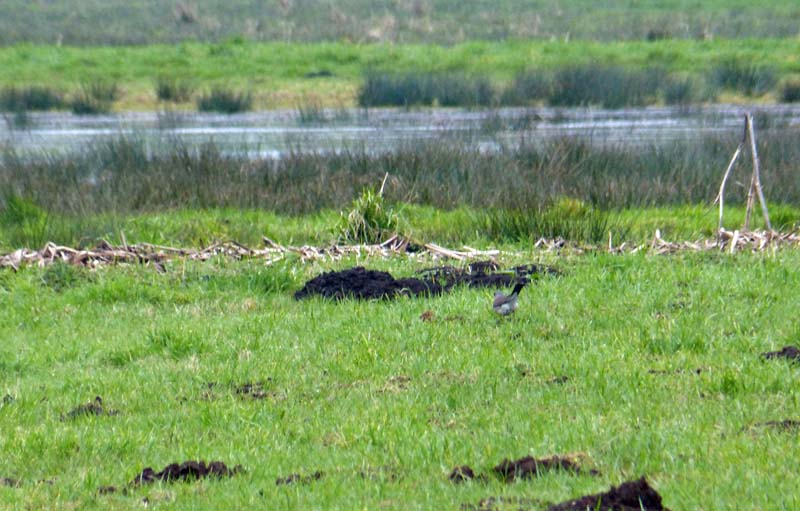 Once at the hide, we had this general view ahead of us.
Once at the hide, we had this general view ahead of us. Looking round, and closing in a little with binoculars and camera, here are other aspects.
Looking round, and closing in a little with binoculars and camera, here are other aspects.
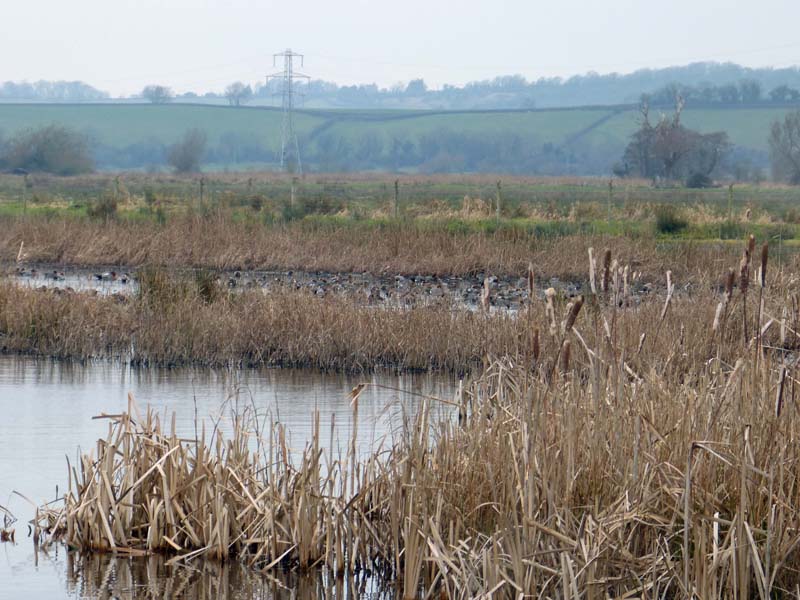


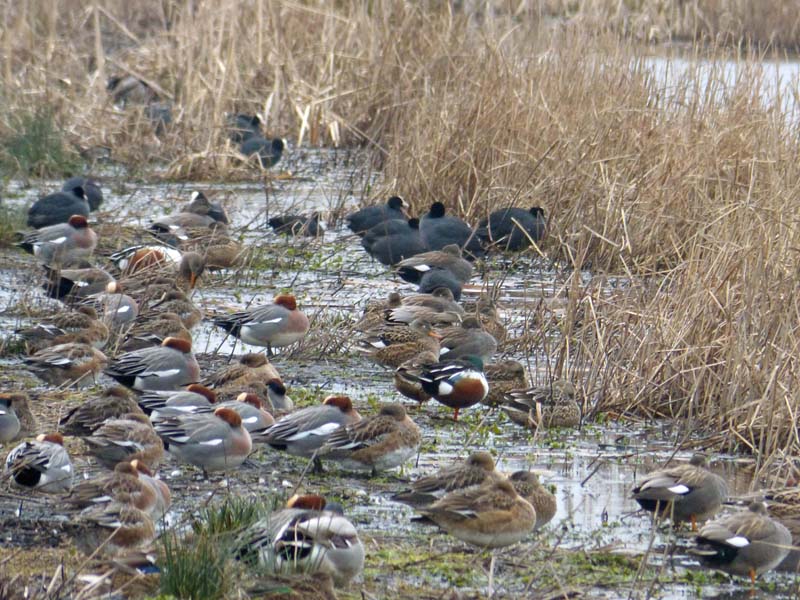
 Experienced birders were soon exclaiming at this clump, just 20 metres or so from us.
Experienced birders were soon exclaiming at this clump, just 20 metres or so from us. A pair of teal can be seen easily, especially the male. But are there really snipe there? And four?
A pair of teal can be seen easily, especially the male. But are there really snipe there? And four? In due course I managed to find three, and indeed once you knew that they were there, it was even possible to pick the nearest one out with the naked eye, they were so close. But what wonderful camouflage! They didn’t move the whole of the time we were there.
In due course I managed to find three, and indeed once you knew that they were there, it was even possible to pick the nearest one out with the naked eye, they were so close. But what wonderful camouflage! They didn’t move the whole of the time we were there.

 And as at Ham Wall, there was a Great white egret in the distance.
And as at Ham Wall, there was a Great white egret in the distance.
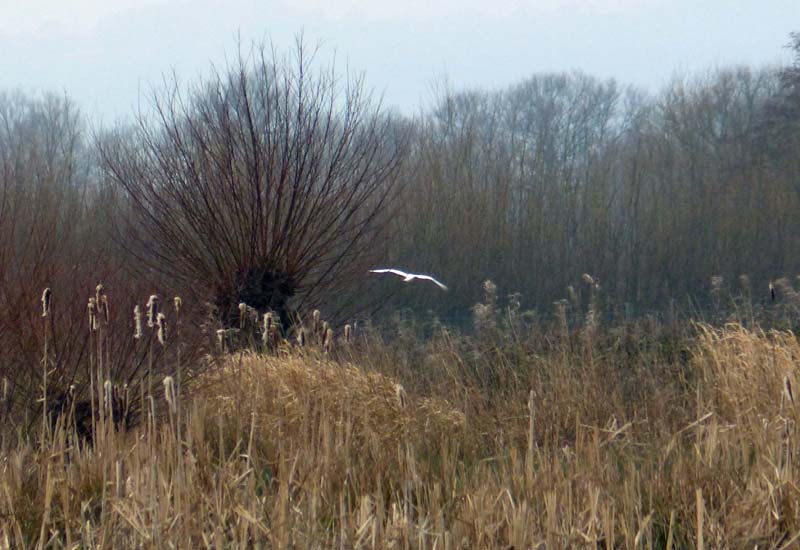
 To the left, the other part of the otter path could be seen.
To the left, the other part of the otter path could be seen. We were pleased then to see crowds and crowds of lapwing flying around, as if there had been a signal to the thousands in the area all to rise up at once. Here are just a few of them.
We were pleased then to see crowds and crowds of lapwing flying around, as if there had been a signal to the thousands in the area all to rise up at once. Here are just a few of them.
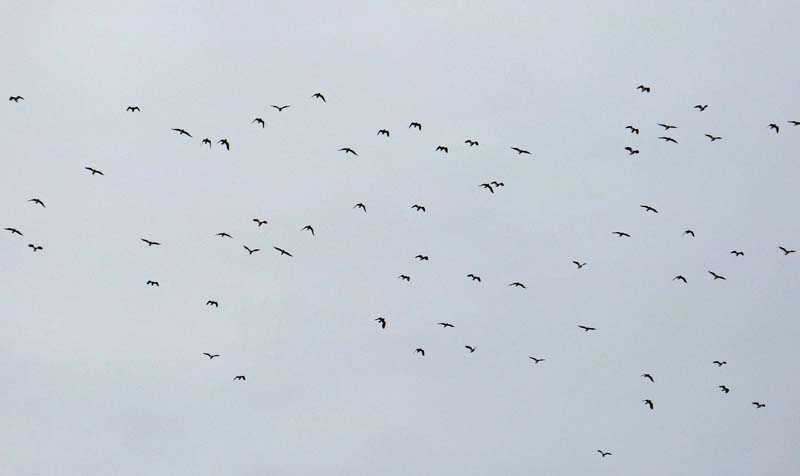 Swans have no need to fear humans, and they know it. This one made for an easy photo, just a very few metres away from where we were walking.
Swans have no need to fear humans, and they know it. This one made for an easy photo, just a very few metres away from where we were walking. A distant view of another great white egret.
A distant view of another great white egret. Evidence of a recent hare boxing match.
Evidence of a recent hare boxing match. And of a sparrowhawk kill.
And of a sparrowhawk kill. We hoped to see more small birds, and indeed we did see redwing, and stonechat, but I couldn’t get photos. We went on to a viewpoint:
We hoped to see more small birds, and indeed we did see redwing, and stonechat, but I couldn’t get photos. We went on to a viewpoint: But few wetland birds were favouring this area of the reserve.
But few wetland birds were favouring this area of the reserve.  Perhaps, along with the small birds, they were favouring the more sheltered areas on this chilly day. But I, usually spending far too much of my life in front of a computer, had really enjoyed my three outdoors outings this week. I must do it more often, and certainly return to Greylake at other seasons.
Perhaps, along with the small birds, they were favouring the more sheltered areas on this chilly day. But I, usually spending far too much of my life in front of a computer, had really enjoyed my three outdoors outings this week. I must do it more often, and certainly return to Greylake at other seasons.









 En route I observed
En route I observed 






 and it was time to wander back to the car park, along the rhyne.
and it was time to wander back to the car park, along the rhyne.











































































































